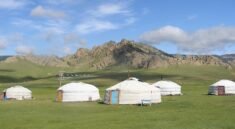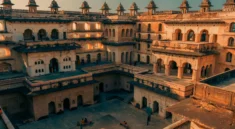
In the northernmost reaches of the Earth, beyond snow-draped forests and across frozen tundra, the sky comes alive. It dances, glows, swirls, and pulses in waves of green, purple, red, and blue — a celestial ballet that defies logic and invites awe. This is the Aurora Borealis, or the Northern Lights: nature’s most magical show under the Arctic skies.
To witness it is to feel something stir in your soul. The experience transcends travel or tourism. It is an awakening — a moment when the vastness of the universe seems to whisper directly to you, and the stars open a door to something ancient, mystical, and deeply human.
The Journey North: Entering The Realm Of Ice And Sky
Reaching the Arctic is an adventure in itself. Whether you fly into Tromsø in Norway, venture into Swedish Lapland, journey across the tundra of Finnish Lapland, or explore the remote wilderness of northern Canada, Greenland, or Iceland, you’re entering a place where the world as you know it feels suspended.
The days are short in the polar winter — sometimes just a faint twilight that glows for a few hours. Snow blankets everything. Reindeer leave tracks in the powder. The air is crisp, clean, and shockingly silent. There are no honking cars or glowing cityscapes. Here, time seems to stretch, slow, and shimmer.
You’ve come to the edge of the world, but the true destination is above.
Chasing The Lights: A Lesson In Patience And Wonder
The Northern Lights cannot be scheduled. They don’t perform on demand. They appear when they wish — ethereal, elusive, and untamed. This is what makes them so special.
Chasing them becomes a ritual. You check aurora forecasts, track solar activity, and scan cloud maps. You bundle up in layers of wool and thermal gear. You drive into the wilderness with guides who have lived under these skies all their lives. You wait — in forests, on frozen lakes, atop mountains, or inside cozy cabins.
Sometimes you wait for hours. The sky is black. Stars shine. You question whether they’ll come. And then, with no announcement or warning — they arrive.
The First Glimmer: A Portal To The Extraordinary
It often begins subtly. A gray streak stretches across the sky, faint as breath. Then it intensifies — shifting to green, then deepening into neon. It curls, splits, and twists. Suddenly the entire heavens are aflame with movement. The lights seem alive — intelligent even — responding to your presence.
They ripple and fold, surge and descend, brushing the treetops. They swirl into coronas — explosions of light that radiate from a central point like a divine eye. The Arctic sky becomes a canvas, and the aurora the brush of some unseen artist.
In that moment, you are not just looking up — you are inside the light. It surrounds you, seeps into you, transforms you. It’s not a show. It’s a dialogue between the Earth and the cosmos, and you are blessed to witness it.
The Science Behind The Magic
While the aurora feels magical, its origins are cosmic. The phenomenon is created when charged particles from the sun collide with Earth’s magnetosphere, funneling energy toward the poles. When these particles strike atoms in Earth’s atmosphere — mainly oxygen and nitrogen — they emit photons. These emissions are what we perceive as shimmering ribbons of light.
Different gases create different colors:
- Oxygen at higher altitudes produces red.
- Oxygen at lower altitudes glows green.
- Nitrogen gives off purple and blue hues.
The solar wind, Earth’s magnetic field, and the tilt of our planet all play roles in this cosmic dance. And while science can explain it, it cannot diminish the awe. If anything, knowing what causes the aurora only deepens the mystery. The same sun that warms our planet sends particles across millions of kilometers to paint the Arctic sky.
Indigenous Lore: The Spirits In The Sky
Long before satellites and science, the peoples of the North had their own explanations for the aurora — stories passed down through generations. In Sámi, Inuit, and First Nations cultures, the Northern Lights are not just a phenomenon; they are spirits, omens, and guides.
Some believed the lights were the souls of ancestors dancing in the sky. Others said they were celestial fires lit by the gods. In Greenlandic legend, the aurora was thought to be the spirits of children playing with a walrus skull in the heavens. In Finnish, the word for the lights — revontulet — means “fox fires,” based on a story that an arctic fox dashed across the snow, sweeping sparks into the sky with its tail.
These stories lend depth to the experience. As you stand under the glowing sky, it’s impossible not to feel that you are part of something greater — a story that began long before you and will continue long after.
Arctic Stillness: Silence That Speaks
Seeing the aurora is not just about color and motion. It’s about stillness. The kind of deep, enveloping silence that only exists in nature untouched by machines. The snow absorbs all sound. The wind whistles low. Your breath forms clouds in the frigid air.
In this silence, your senses expand. You hear your heartbeat. You feel your feet in the snow. Your mind stops racing. Time stretches. You are entirely present. Entirely human.
For many, this is the most profound part of the experience. Under the aurora, you are reminded of your smallness — and also your connection to everything. You realize that your worries, your deadlines, your endless notifications — none of them matter here.
Life At The Edge: Embracing The Arctic
The Arctic is not just a backdrop for the lights. It is a world unto itself. Life here is resilient, hardy, and beautifully simple. You might stay in wooden lodges, ice hotels, or glass-roofed cabins designed for aurora viewing. You might travel by dog sled, snowmobile, or even reindeer sleigh. Locals share warm stories, traditional foods, and insight into a life in sync with the seasons.
You’ll taste reindeer stew, drink cloudberry liqueur, and warm up with hot lingonberry tea. You might try ice fishing, or bathe in a sauna before rolling in the snow. These traditions are not gimmicks — they are the heartbeat of a culture that has thrived in cold, darkness, and solitude.
Photography And Memory: Capturing The Uncapturable
Of course, everyone wants to capture the Northern Lights. Cameras, when set properly, can produce breathtaking photos — long exposures revealing the full depth of the aurora’s colors and patterns.
But be warned: the lens is never enough. The camera sees one thing; you feel another. No image can replicate the sensation of standing beneath a pulsing curtain of light, hearing nothing but snow crackle beneath your boots, your heart racing with wonder.
The best photos are the ones etched in your soul — images that return to you in dreams, in quiet moments, in flashes of memory. When you close your eyes weeks later and still see green fire above you, that is when you know the aurora has entered your story.
Reflections Under The Lights
Many who witness the aurora describe it as a spiritual experience. It evokes awe — the kind of awe that silences you, opens your heart, and realigns your perspective. For some, it brings tears. For others, laughter. For all, it brings a sense of belonging — to this planet, to the cosmos, to the quiet beauty of existence.
Under the lights, people reflect. On who they are. On who they want to be. On what really matters. The sky becomes a mirror. The aurora becomes a guide.
You come for a show. You leave with something far more lasting: clarity.
Departure: The Glow Within
Eventually, the night ends. The sky quiets. The stars return. The aurora slips away — sometimes as gently as it arrived, sometimes in a final blaze of glory.
You return to your cabin, the fire crackling, your face tingling with cold and wonder. You sleep, not just from exhaustion, but from completion. You have seen something few on Earth ever truly witness. And you carry it with you — not in your suitcase, but in your soul.
When you return to your busy world, the lights remain. In your memory. In your breath. In your being. You will find yourself looking up more often. Pausing longer. Breathing deeper. Something in you has changed.
You are now part of the ancient circle — one more human who stood under the Arctic sky and saw its most magical performance.
Witnessing the Northern Lights is not about checking a box on a bucket list.
It is about surrendering to beauty. About standing in humility before the universe.
And in that surrender, discovering something radiant — not just in the sky, but in yourself.




